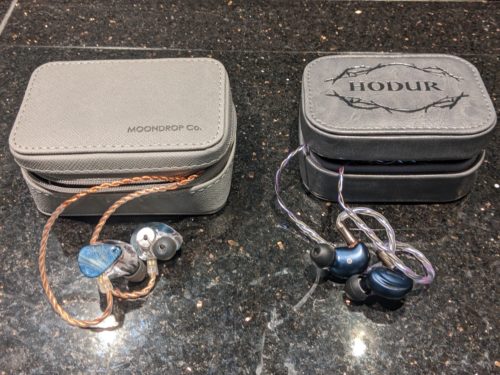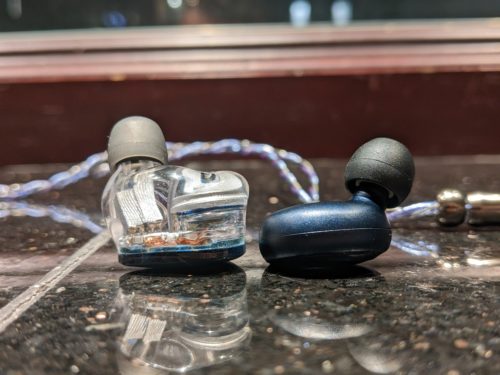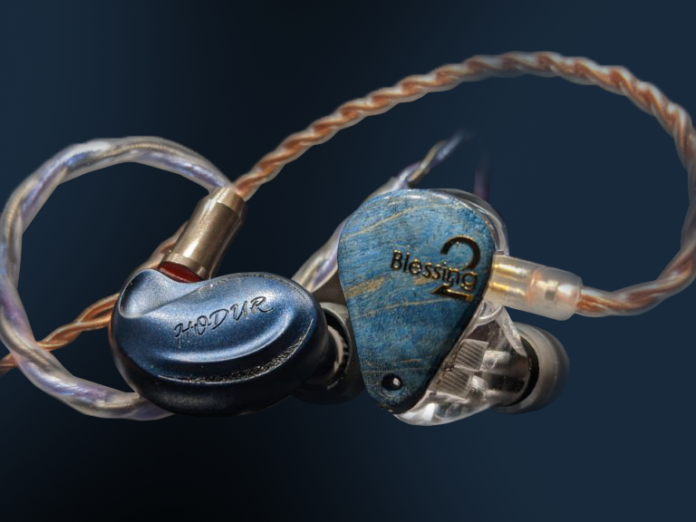Moondrop Blessing 2 vs. Kinera Hodur Review
Today we’ll be putting the Kinera Hodur up against the fairly popular Moondrop Blessing 2. Why this comparison? The Blessing 2 has developed a reputation for being a pretty all-around solid IEM at a moderately affordable $350, and I was left with a similar impression of the $300 Kinera Hodur. Both of these seem to be pretty good options for someone looking for their first pair of “serious” IEMs, or in-ear addicts just looking for a comfortable, casual, and not-terribly expensive addition to their IEM collection. Let’s see what comes with the Blessing 2 and the Hodur, compare their physical and technical design, and most importantly, see what their sound profiles have to offer.
What’s in the Box?

| Moondrop Blessing 2 | Kinera Hodur |
| Moondrop Blessing 2 IEMs
Firm Carrying Case 3.5mm Cable 5 Pairs of Silicone Ear Tips Warranty Card |
Kinera Hodur IEMs
IEM Cable 3.5 unbalanced and 4.4mm balanced jacks 5 sets Final Audio Type E Tips 3 Sets K07 Silicone Tips 3 Sets K-285-02 Silicone Tips Hard Carrying Case Cleaning Tool |
Look and Feel
To my eyes, the Moondrop Blessing 2 is a bit more stylish than the more conventional looking Hodur with its transparent body and gemstone-style design on the back of the IEMs. The Hodur unit I received is a solid-steely blue with some sparkly graphite-like detail in its ridges. The Hodur is fairly discrete, while the Blessing 2 is a particularly pretty IEM.
As far as fit goes, the Hodur is the clear winner in my books – not because the Blessing 2 is uncomfortable, but rather because the Hodur may well be one of the most comfortable IEMs I’ve ever had in my ears. Getting it into my ears can be done in 5 seconds with one hand – no earlobe-tug required. On top of that, the Hodur is particularly small and thin, doesn’t stick out of my ears at all once I have it in place, and has a firm fit with a particularly narrow acoustic nozzle.
The Blessing two is comfortable enough once it’s in my ears, and lacks any problematic or painful corners or edges. However, it’s rather large and chunky, and has a fat acoustic nozzle. Though it did in fact slip into my ear canal easier than most IEMs, it’s not quite the same as the Hodur’s exceptionally easy fit. Ultimately, the I felt the Blessing 2’s presence in my ears, while it was pretty easy to forget that I even had the Hodur in my ears.

Technical Design:
The Moondrop Blessing 2 uses a three-way crossover system that delegates lows to a dynamic driver, mids to 2 balanced armatures, and highs to 2 Dual Knowles SWFK treble drivers. The Kinera Hodur also employs a 3 way crossover, with lows and mids being handled by a dynamic driver, high mids by a balanced armature, and highs by an electrostatic driver.
| Moondrop Blessing 2 | Kinera Hodur |
| Drivers: 1 DD, 4 BA
Impedance: 22 ohms Frequency Response: 9 Hz – 37 kHz Sensitivity: 117 dB |
Drivers: 1 DD, 1 BA, 1 EST
Impedance: 8 ohms Frequency Response: 5 Hz – 40 kHz Sensitivity: 106 dB |
Sound Stage
In the imaging and staging department, the Blessing 2 might edge out the Hodur just slightly. The Blessing 2 seemed to connect the left and right channels in front of my face a little more fluidly. I think balance may play a large part here: the Moondrop Blessing 2 has more distinct layers and definition between parts, which made “locating” their spatial placement easier and more realistic. Though the Kinera Hodur has some layering in the mids and highs, it’s very powerful and widely boosted low end often provides more energy than it does definition, occasionally overwhelming a mix and leaving me with a more linear feeling left-right stage. This may very well play into some people’s preferences when it comes to balance, but the trade off is fairly apparent in terms of the interplay between layering and imaging.
Lows
Both IEMs contain low end boosts, though with different shapes and intensities. The Moondrop Blessing 2 finds moderate emphasis in its subs and mid-bass, settling on a pretty balanced level in its high bass and low mids. The Hodur widely and boldly boosts it low end at both a higher amplitude and wider bandwidth than the Blessing 2, roping even its low mids into this boost. What does this mean for these two IEMs? The Blessing 2’s low end boost targets moments of low end impact – kick drums pop out out of mixes, bass lines find moments of slam. The Hodur’s low end goes beyond momentary low end, and provides a consistent and driving energy that remains present through out mixes: basses are consistently given high priority, and in general, low frequencies in mixes seem more glued together and relentless. The Blessing 2 is a fairly balanced IEM with a moderate low end boost – the Hodur isn’t pretending to be balanced, and is clearly appealing to bass lovers with its driving, rumbling qualities.
Mids
Here, the Blessing 2 emerges as the cleaner IEM, while the Hodur offers a little less balance and a little more color. With the Blessing 2, guitars and vocals find a particularly balanced mid range, and come out sounding rather neutral and natural (though we’ll come back to this when discussing the highs). The Kinera Hodur has a pretty apparent lower mid boost, which brings up the lower hum of guitar parts and vocal fundamentals. It’s as if one can hear that the dynamic driver in the Hodur is dedicated to lows and mids alike, as there is certainly a continuous character between the two. Sometimes this lower-mid boost in the Hodur leads to some muddy sounding moments when listening to rock music or music with traditional arrangements, but it can deliver a face-melting energy when listening to more electronic music.
Highs
The Moondrop Blessing 2 has a light, moderately extended, and somewhat airy treble profile. This provides lift to vocals, bright sparkle for guitars, and extra crispness to cymbals and hi-hats; it’s the high end that finally ends up giving the Moondrop 2 some distinct sense of color and character. The Hodur, on the other hand, finds a different use for its treble. With most of its personality found in its driving and heavy lows and mids, the highs seem to be more concerned with maintaining a sense of realism rather than finding some sort of creative boost or flourish. Luckily, it accomplishes this goal, though the high end isn’t particularly extended and the roll off seems a little steep – something I didn’t necessarily notice in my original review for the unit, but it’s the sort of detail that a comparison can sometimes bring out.
Overall
I made this review primarily for those considering fairly affordable IEMs that hold a good value – whether it’s your first “serious” IEM, or just something to add to the collection. Both the Moondrop Blessing 2 and the Kinera Hodur are great options that meet this criteria, though for very different reasons. If clean, fairly balanced sound is what you’re after, the Blessing 2 would be the way to go. For a spunkier, bassier, and arguably more fun and energetic in-ear monitor, the Hodur is looking like a pretty great option. I’m not shy about sharing my preferences in these comparison reviews, but I genuinely don’t put one above the other; they’re both all around solid picks even as they set out to accomplish different things. Though I have to say: don’t undervalue just how comfortable Kinera’s Hodur is in your ears, it’s the sort of thing that will seriously grow on you the longer you use it.
The Kinera Hodur and Moondrop Blessing 2 can be purchased from Audio46.
| Kinera Hodur | Moondrop Blessing 2 |
| -Fun and thick low end – more about energy than definition
-Driving character -Extremely comfortable |
-Clean, fairly balanced and revealing character with a touch of boost in the lows – emphasis in the highs.
– Fairly comfortable, but chunky. |
Compare the ranking of various headphones, earbuds and in-ear monitors using our tools.
Discuss this, and much more, over on our forum.
---MAJORHIFI may receive commissions from retail offers.














